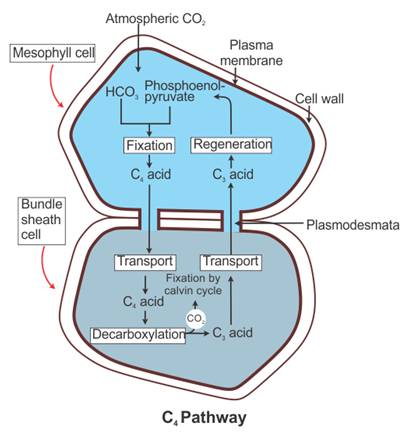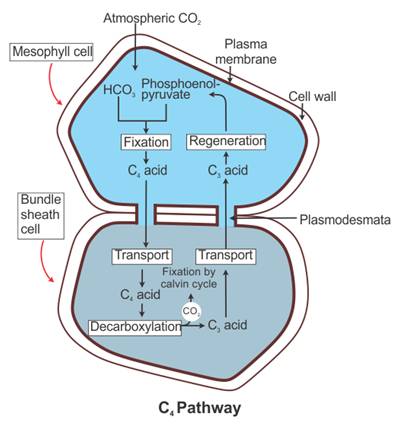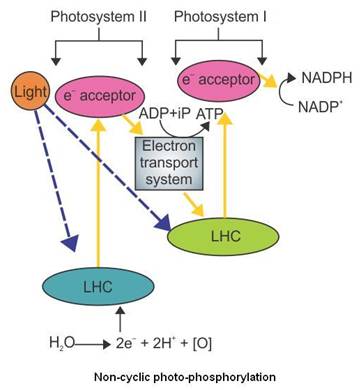Q1. What is the saturation limit for CO2 in C3 and C4
plants?
Solution
The saturation values for CO2
are
C4 plants: At about 360 μlL−1
C3 plants: Above 450 μlL−1
Q2. Differentiate between C3 and C4 plants on the
basis of anatomy.
Solution
C3
plants
C4
plants
Kranz anatomy is absent
in leaves.
Leaf shows the presence
of Kranz anatomy, with bundle sheath cells arranged around the vascular
bundle.
Chloroplasts are of a
single type with the presence of grana.
Chloroplast is
dimorphic. Chloroplasts of mesophyll cells have grana and those of bundle
sheath cells do not.
Q3. Draw a standard graph for light intensity versus the rate of
photosynthesis.
Solution

Q4. What governs the internal factors affecting the rate of photosynthesis?
Solution
Genetic predisposition and growth of the plant determine the internal
factors which affect the plant.
Q5. The membrane system of chloroplast is responsible for the synthesis of
which two molecules?
Solution
ATP and NADPH
Q6. What is the anatomical structure of the leaves of C4 plants
known as?
Solution
Kranz anatomy
Q7. In which region of the visible light spectrum does most photosynthesis
take place?
Solution
Most photosynthesis corresponds to the blue and red regions of the
visible spectrum.
Q8. The Calvin cycle occurs in plants following which pathway?
Solution
The Calvin cycle occurs in all photosynthetic plants irrespective of
whether they have the C3 or C4 pathway.
Q9. Give the equation for photolysis of water and give the fate of each of
the products so formed.
Solution
2H2O ————› 4H+ + O2
+ 4e−
The products so formed are
H+/protons - These are used for the reduction
of NADP to NADPH.
Oxygen - It is liberated in the air and replenishes
oxygen in the environment.
Electrons - These are used to replace electrons
lost by PS II.
Q10. Name the site for the following in C4 plants:
PEP regeneration
Calvin cycle
Solution
Q11. Describe the experiment performed by T. W. Engelmann to determine the
first action spectrum of photosynthesis.
Solution
Engelmann used a prism to split light into its spectral components,
and then illuminated a green alga, Cladophora, placed in a suspension
of aerobic bacteria. The bacteria were used to detect the sites of oxygen
evolution.
He observed that bacteria mainly accumulated in the region of blue and
red light of the split spectrum, thus giving the first action spectrum of
photosynthesis.
Q12. Internally, the chloroplast consists of which fluid?
Solution
Stroma
Q13. Which pigment forms a bright blue or blue-green colour band on a
chromatogram for pigments of green leaf?
Solution
Chlorophyll a
Q14. Factors affecting the rate of photosynthesis are grouped under which
two categories?
Solution
External factors and internal factors
Q15. Differentiate between PS I and PS II.
Solution
Photosystem
I
Photosystem
II
It has absorption maxima at 700 nm.
It has absorption maxima at 680 nm.
It operates in both cyclic and non-cyclic photophosphorylation.
It operates only in non-cyclic
photophosphorylation.
Q16. At what concentration of full sunlight does saturation of light take
place for photosynthesis?
Solution
10% of full sunlight is the saturation limit for photosynthesis.
Q17. Why is photorespiration called a wasteful process?
Solution
In photorespiration, there is no synthesis of ATP or NADPH; thus, it
is called a wasteful pathway.
Q18. Expand RuBP. Give its role in photosynthesis.
Solution
Ribulose bisphosphate
It acts as the first acceptor molecule of CO2 and forms the
first stable compound of the biosynthetic phase.
Q19. Give a detailed account of the Hatch and Slack pathway with the help
of a diagram.
Solution
- The Hatch and Slack pathway is a cyclic pathway for CO2 fixation.
- The primary CO2 acceptor is a 3-carbon compound phosphoenol pyruvate (PEP) which is present in mesophyll cells.
- PEP in the mesophyll cells is converted to oxaloacetic acid (OAA), which is then further converted into a 4-carbon compound such as malic acid or aspartic acid, which is then transported to the bundle sheath cells.
- In the bundle sheath cells, it is again broken down into a 3-carbon compound with the release of CO2.
- The CO2 released enters the Calvin cycle in the bundle sheath cells, while the 3-carbon compound is transported back to the mesophyll cells.
- In the mesophyll cells, the 3-carbon compound is converted back to PEP, thus completing the cycle.

Q20. Define photosynthesis.
Solution
Photosynthesis is a physicochemical process by which green plants and
certain other organisms use light energy for synthesising organic compounds.
Q21. In which photophosphorylation process both ATP and NADPH are produced
and in which only ATP is produced?
Solution
In non-cyclic photophosphorylation, both ATP and NADPH are produced. In
cyclic photophosphorylation, only ATP is produced.
Q22. How is oxygen produced during photosynthesis?
Solution
During non-cyclic photophosphorylation, PS I passes its electron to
NADP+ for the production of NADPH + H+. This lost
electron of PS I is obtained from PS II, which in turn obtains its electron from
the splitting of water. When the water molecule is split to provide an
electron to PS II, it produces protons as well as oxygen which is released
out as a molecule of oxygen.
Q23. Give the empirical formula for photosynthesis.
Solution

Q24. Name the different stages of the Calvin cycle.
Solution
The Calvin cycle comprises three stages:
Carboxylation
Reduction
Regeneration
Q25. Name the factors important for photosynthesis.
Solution
Sunlight, carbon dioxide and chlorophyll
Q26. Which pigments constitute the accessory pigments in the thylakoid?
Solution
Accessory pigments include
Chlorophyll b
Xanthophylls
Carotenoids
Q27. Give a diagrammatic representation for the C4 pathway.
Solution

Q28. State the effect of CO2 concentration on C3 and
C4 plants under the following conditions:
Low light and high CO2 concentration
High light intensities
Saturation CO2 concentration
Solution
Q29. Give a diagrammatic representation of cyclic and non-cyclic
photophosphorylation.
Solution


Q30. What is the biosynthetic phase also known as? Why is it called so?
What products does it require and what is the end-product of the process?
Solution
The biosynthetic phase is also called the dark reaction.
It is called so because it does not require the presence of light for
its commencement; that is, it is light-independent.
The products necessary for the biosynthetic phase are ATP and NADPH,
which are obtained from the light reactions. The final product of the biosynthetic
phase is sugar (glucose).
Q31. What do ATP and NADPH stand for?
Solution
ATP - Adenosine triphosphate
NADPH - Nicotinamide adenine dinucleotide phosphate
Q32. For the production of one molecule of glucose by Calvin cycle, how
many molecules of CO2 need to be fixed?
Solution
Six molecules of CO2 are fixed for the production of one
molecule of glucose by the Calvin cycle.
Q33. How are molecules of the C4 cycle exchanged between the
mesophyll and bundle sheath cells?
Solution
The molecules of the C4 pathway are exchanged through the
plasmodesmata, which are pore-like channels that connect the mesophyll and
bundle sheath cells.
Q34. Julius von Sachs provided evidence for which facts based on his experiment
on green plants?
Solution
He found that the green parts of the plant make glucose, and glucose
is usually stored in the form of starch.
Q35. List the internal and external factors which affect the rate of
photosynthesis, and give details on three external factors.
Solution
- At low light intensities, there is a linear relationship between incident light and CO2 fixation rates.
- At high light intensities, the rate of photosynthesis does not increase but other factors become limiting.
- Light saturation occurs at 10% of full sunlight.
- Light is usually not a limiting factor, but when light intensity increases beyond a point, it causes break down of chlorophyll and decrease in photosynthesis.
- Temperature mainly affects the dark reaction of photosynthesis.
- C4 plants respond to higher temperatures and show higher rates of photosynthesis.
- C3 plants, on the other hand, have a much lower temperature optimum.
- The temperature dependency of plants for the rate of photosynthesis also depends on the habitat which the plant is living and the group of plants to which it belongs.
- Water affects the rate of photosynthesis indirectly.
- Water stress causes the stomata to close in order to reduce transpiration. Closed stomata lead to decrease concentration of CO2 in the cells, thus resulting in decrease in photosynthesis.
- Water stress also causes the leaves to wilt, thus reducing the surface area for photosynthesis.
Q36. How does water affect the rate of photosynthesis?
Solution
Water affects the rate of photosynthesis
indirectly. Water stress causes the stomata to close, thus reducing the
availability of CO2. It also causes the leaves to wilt, reducing
the surface area for photosynthesis.
Q37. How did Melvin Calvin find the first stable compound formed in the
biosynthetic phase?
Solution
Calvin used 14C, a radioactive isotope of carbon, in CO2
which he supplied to the green photosynthetic algae which he used for his
studies. The algae used up the CO2 for fixation in photosynthesis.
He observed that the first compound formed after some time with the presence
of the radioactive 14C was 3-phosphoglycerate, suggesting it as
the first stable compound of CO2 fixation.
Q38. Define photolysis of water.
Solution
It is the process by which water is split into H+, oxygen
and electrons in the presence of light by photosystem II.
Q39. How is the yield of greenhouse crops such as tomato and bell pepper
increased through photosynthesis?
Solution
The yield in greenhouse crops of tomato and
bell pepper is increased by growing them in a carbon dioxide-rich
environment.
Q40. The splitting of water occurs in which part of the chloroplast? What
is its significance?
Solution
Splitting of water takes place near PS II, located in the inner side
of the thylakoid membrane.
Splitting of water releases oxygen in the atmosphere and generates a
proton gradient across the thylakoid membrane.
Comments
Post a Comment